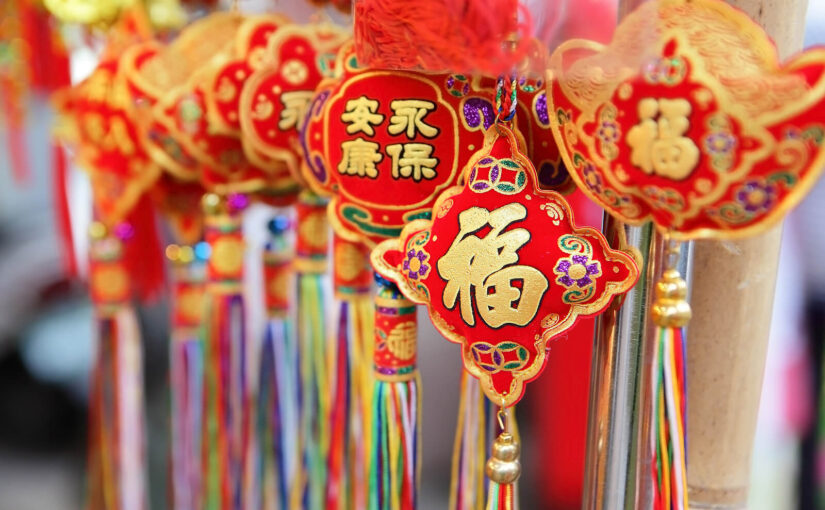The Lunar New Year is a cherished celebration embraced by communities and cultures spanning East and Southeast Asia. This celebration resonates deeply worldwide, where diaspora communities keep the traditions alive.
Today, we’re delving into the vibrant tapestry of Chinese New Year celebrated in the UK.
Also known as the Spring Festival, Chinese New Year customs centre around new beginnings. From spring cleaning to feasting with family, adorning homes with luminous lanterns, and exchanging promising red envelopes, its customs embody luck and prosperity in the coming year.
As we revel in these rich and colourful traditions, it’s worth pondering their ecological footprint. Can we honour the heritage while treading a more sustainable path?
Let’s explore green ways to paint the town red for a more sustainable Chinese New Year.
1. Recycle when spring cleaning
The tradition of spring cleaning and decluttering takes place before the Chinese New Year to expel negative energy from the home and invite good fortune.
As you embark on this cleansing journey, purging your home of dirt, dust, and unwanted items is imperative. Instead of throwing everything into the general waste bin or a skip, sort your rubbish into waste streams.
Make a positive environmental impact by depositing recyclables into the correct recycling bins. Find new homes for items still in good condition, like clothing, furniture, and electronics.
You can embrace a more sustainable lifestyle by transitioning to reusable products and adopting a mindset of mindful consumption. This will reduce the waste generated during future spring cleans.
2. Reuse decorations
Following the thorough cleaning and decluttering, the festive transformation of the house begins with the adornment of vibrant red decorations.
Trimmings typically include ornate Chinese lanterns believed to ward off negative energies, door couplets conveying blessings for the upcoming year, and delicate paper cuttings symbolising luck and joy. Flowers and kumquat trees are also popular, with blooms representing prosperity and kumquat trees standing for wealth and good fortune.
In the spirit of sustainability, consider reusing decorations from previous years. If new additions are necessary, choose timeless pieces devoid of zodiac-specific motifs so they can be reused. Many decorations are crafted from paper or cardboard, so store them in a dry environment away from direct sunlight to preserve their condition.
When the Chinese New Year flowers wilt, harness their organic potential by composting them alongside food scraps and garden waste, creating nutrient-rich soil for future growth.
3. Wear new-to-you red clothes
Tradition dictates donning new clothes for the Chinese New Year festivities — preferably in red. New clothing symbolises fresh starts and renewed hope, and red is believed to attract luck and ward off evil spirits.
Historically, female family members would lovingly sew or knit these garments for their loved ones, but nowadays, a shopping trip is more common.
Unfortunately, fast fashion poses significant environmental concerns. Purchasing garments destined for just one wear creates extra textile waste, carbon emissions, and air and water pollution.
Rather than buying brand-new items, why not explore the wealth of pre-loved treasures available? Charity shops and online platforms like Vinted and eBay offer thousands of second-hand options ripe for discovery.
Another sustainable approach is to engage in clothes swaps within your family or community. By exchanging outfits worn during previous Chinese New Year celebrations, no additional garments need to be manufactured or transported, making this a cost-free and eco-friendly choice.
Recycling last year’s red attire presents another eco-conscious option for those who are flexible about garments being new.
By being mindful of your clothing choices this year and prioritising long-lasting and versatile pieces, you can be kinder to the environment and ensure the outfits bring joy for many years.
4. Send digital red packets

The red packet —hóngbāo in Mandarin and lai see in Cantonese — is a gift of money given to children, unmarried individuals, and service providers at Chinese New Year.
Vibrant red envelopes are traditionally filled with banknotes, symbolising wishes for luck and prosperity in the upcoming year. When giving or receiving a red envelope, using both hands is customary. Blessings and well wishes are passed to the recipient as the envelope is handed over.
The popularity of red packets comes with environmental consequences. In Hong Kong alone, an astounding 320 million red envelopes are exchanged annually, resulting in the felling of approximately 16,300 trees.
The preference for crisp new banknotes adds to the environmental toll, with Singapore alone generating 330 tonnes of carbon emissions during production. This is equivalent to powering 5.7 million smartphones for five days.
Recognising these ecological concerns, electronic alternatives are gaining traction, particularly among younger generations. E-hóngbāos offer a convenient and eco-friendly solution, allowing users to select a design, specify an amount, and send their digital gifts with a simple click. This method significantly reduces the waste and carbon emissions of traditional red packets.
Reusable red envelopes present a sustainable alternative for those who prefer to maintain tradition or are less inclined towards technology. Choose plain designs without zodiac motifs and secure them with a gentle tuck instead of adhesive seals.
5. Reduce and redirect food waste
Food waste poses a significant challenge during Chinese New Year festivities, given food’s central role in the celebrations and the hosts’ desire to ensure guests are well-fed. Additionally, restaurants often overorder out of concern for shortages during the festivities.
If you’re hosting and you bought too much food last year, alter your shopping list and recipes this year to reduce food waste.
A steamed whole fish is typically the centrepiece of the Chinese New Year dinner table, representing prosperity and abundance for the year ahead. This year, contribute to the future abundance of fish stocks by selecting the most sustainable fish available.
Sustainability can be integrated into other traditional dishes with simple adjustments to reduce your carbon footprint. Consider substituting meat with local vegetables to decrease carbon emissions instantly.
Another aspect to consider is the traditional candy box, known as chuen hup, which is traditionally filled with nuts, seeds, and candies. To fill yours, choose locally sourced items from a zero-waste shop to minimise packaging waste. If you don’t have one nearby, prioritise purchases with minimal packaging to fill the candy box sustainably.
Dispose of your food waste in a food waste recycling bin or a compost bin. Unopened food items can be donated to food banks or shared with others through platforms like Olio. Restaurants can use the Too Good To Go platform to create revenue from unsold food.
By implementing these sustainable practices, you can enjoy the usual Chinese New Year traditions while mitigating the environmental impact of your celebrations.
Wishing you a lucky, prosperous, and sustainable Chinese New Year. Kung Hei Fat Choy!
